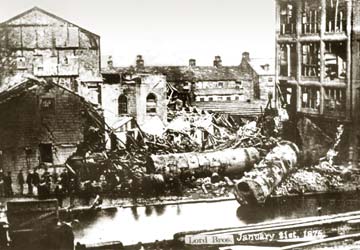|
Home Subscriptions Send us your memories Buy online Links ISSUE 8 CONTENTS "A Fearful and Dreadful Calamity" The Fire that Destroyed a Retail Gem Why Lanebottom Celebrated Twice |
"A Fearful and Dreadful Calamity" Click photo to enlarge The aftermath of the massive explosion which devastated Lord Brothers' Mill, Todmorden, in 1875 is all too evident. Such was the stir caused "souvenir" postcards such as this were quickly put on sale by an enterprising local photographer. Code no 129 RD ALGC Nearly 130 years ago a mill explosion shook Todmorden to its core. It is still regarded as one of the town's worst industrial disasters. Twelve people died and many more were injured in the massive explosion at Lord Brothers Mill in 1875, when eye witnesses described the event "like a rocket going up." One of three large boilers servicing the five-storey mill had blown up, pieces of metal flying in all directions and the force so great the boiler house was flattened, tanks landing on the nearby towpath and blocking the canal. The explosion was heard in Hebden Bridge, people as far away as Halifax claiming to have seen the pall of steam and smoke which hung over Todmorden until sunset. The disaster, described as "A Fearful and Dreadful Calamity" by the local press, occurred just after 1.30 pm on January 21 1875 - just as the 500 mill-hands employed by Lord's were returning from their dinner-break for work in the sheds. As news of the disaster spread hundreds of anxious relatives gathered at the scene where the search through tons of debris frantically started. Some men were known to have been in a small shed just behind the boilerhouse, where they liked to gather for a smoke and a chat. Four lifeless bodies were discovered. At the inquest it was revealed that 17 months previously an inspection had been made and the advice given that the boilers should be replaced. Instead the overseer, Edmund Woodhead, had them repaired. Returning a verdict of death as a result of the explosion the jury added: "We are of the opinion that the explosion was caused by excessive corrosion and grooving of the plates of the boiler and that there was an error of judgement on the part of Edmund Woodhead which led him to believe that the boiler was safe and in working condition." Read the full story in Milltown Memories, issue 8. If this or other stories stirs a memory, we'd be happy to know - send us your memories and comments. |

